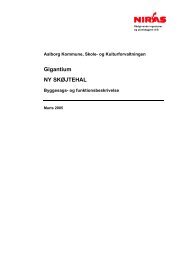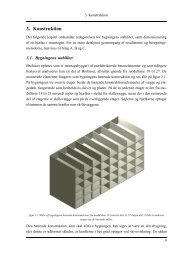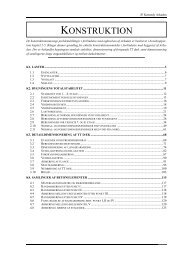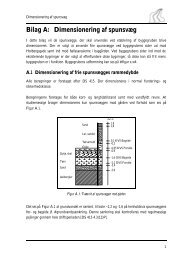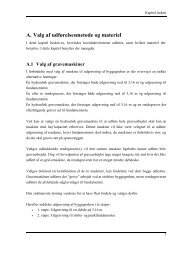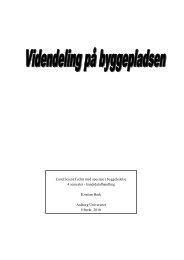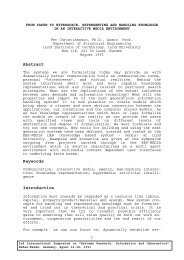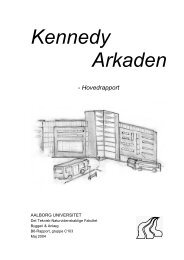IDM Exchange Requirements - It.civil.aau.dk
IDM Exchange Requirements - It.civil.aau.dk
IDM Exchange Requirements - It.civil.aau.dk
Create successful ePaper yourself
Turn your PDF publications into a flip-book with our unique Google optimized e-Paper software.
<strong>IDM</strong><br />
<strong>Exchange</strong> <strong>Requirements</strong><br />
Jeffrey Wix
<strong>IDM</strong> Technical Architecture<br />
Focus on <strong>Exchange</strong> <strong>Requirements</strong>
<strong>IDM</strong> Technical Architecture<br />
• REMINDER<br />
• A set of information that needs to be exchanged to support a<br />
particular business requirement at a particular stage of a project<br />
• provides a description of the information in non technical terms
Users<br />
• aware of process and<br />
business impacts<br />
• doesn’t need technical<br />
detail about use of<br />
information in the process<br />
• does not need to know<br />
about software or format<br />
• needs to know what<br />
information to expect<br />
and how to use it in<br />
the business process<br />
• does not need to know<br />
about software or<br />
format<br />
• writes software + data<br />
exchange interface<br />
• needs to know what<br />
users expect from<br />
software<br />
• needs to know about<br />
the exchange format
<strong>Exchange</strong> Requirement<br />
Actor Requesting Information to Support a Process or Decision<br />
(Authoritative Reference OMNI CLASS – Table 33 & 34)<br />
Why is this information important for a project activity<br />
(Authoritative Reference OMNI CLASS- Table 32)<br />
(Authoritative Reference OMNI-CLASS-Table 31) Table 31 is tied to Ifc<br />
Phases (Project Lifecycle) Table 22 for Construction Phasing<br />
Dataset in BIM that supports the request and benefit)<br />
Because BIM use aggregates Information Several Tables Support this activity.<br />
Authoritative Reference OMNI-CLASS Tables 14, 21, 23, 41, 49.<br />
Group/Actor that provides/fullfills the information need OMNI-Class 33. 34<br />
Courtesy: Dianne Davis, AEC Infosystems
WHAT<br />
• A set of information that needs to be exchanged to<br />
support a particular business requirement at a particular<br />
stage of a project.<br />
• An exchange requirement is independent of the format<br />
in which data will be shared.<br />
– <strong>It</strong> can be used to support requirements in any situation<br />
• Industry Foundation Classes (IFC)<br />
• Geographic Markup Language (GML)<br />
• CIMsteel Integration Standards<br />
• etc.<br />
• An exchange requirement is intended to provide a<br />
description of the information in non technical terms.<br />
• The principal audience for an exchange requirement is<br />
the user (architect, engineer, constructor etc.).
WHY<br />
• IFC supports all business<br />
requirements at all project stages.<br />
• used to capture all project<br />
information<br />
• does not capture day to day<br />
transactions<br />
• support for one business process<br />
over multiple project stages<br />
• capture day to day transactions<br />
• consistent with IFC<br />
• support what solution providers need<br />
to implement
Neutral Format Data <strong>Exchange</strong><br />
• Common representation of<br />
information for exchange is a<br />
good idea.<br />
• But it’s like world peace<br />
• You have to figure out what it is<br />
and then work at it
Model Server<br />
Sharing all information on a<br />
project through a model server or<br />
database at the heart of the<br />
enterprise
<strong>Exchange</strong> <strong>Requirements</strong><br />
<strong>Exchange</strong> requirements (either as<br />
files or as model server/database<br />
queries) define the anatomy of a<br />
project.
WHO
WHEN<br />
An ‘<strong>Exchange</strong> Requirement’ is always shown in a process map<br />
as a data object within the Information Model swimlane.
Standard Project Stages<br />
• <strong>Exchange</strong> requirements developed<br />
by:<br />
– different people<br />
– in different places<br />
– at different times,<br />
• Need consistency in the<br />
identification of the stages in a<br />
project<br />
• Without consistency, it is not<br />
possible to bring exchange<br />
requirements together in an<br />
information framework.<br />
• Standard exchange requirements<br />
in <strong>IDM</strong> use project stages from the<br />
Generic Process Protocol (GPP).
GPP Project Stages
Localizing Project Stages<br />
• Generic project stages are useful for creating a global standard<br />
• But they are not useful for real projects in real places<br />
• Generic project stages need to be mapped to local standard stages<br />
• RULES<br />
– Standard stages and local protocol stages should always conform to<br />
boundaries such that there is a 1:1, 1:many or many:1 relationship<br />
between them.<br />
– Project stages must not cross boundaries such that a stage in a local<br />
protocol starts part way through one standard stage and ends part way<br />
through another standard stage.
Localizing Project Stages (1)
Localizing Project Stages (2)<br />
15 00 00 Project Delivery Selection Stage<br />
15 10 00 Project Delivery Evaluation Method Phase<br />
15 20 00 Team Assembly Phase<br />
15 20 11 Design Team Selection Phase<br />
15 20 14 Project Team Selection Phase<br />
15 20 17 Design/Builder Selection Phase<br />
15 20 21 Construction Manager Selection Phase<br />
15 20 24 Request for Qualifications (RFQ) Phase<br />
15 20 27 Request for Qualifications (RFQ) Evaluation Phase<br />
15 20 31 Request for Proposals (RFP) Phase<br />
15 20 34 Request for Proposals (RFQ) Evaluation Phase<br />
15 20 37 Interview Phase<br />
20 00 00 Design Stage<br />
20 10 00 Preliminary Project Description Phase<br />
20 10 11 Preliminary Engineering Phase<br />
20 10 14 Conceptual Design Phase<br />
20 10 17 Schematic Design Phase<br />
20 10 21 Preliminary Design Phase<br />
20 20 00 Design Development Phase<br />
20 20 11 Detailed Design Phase<br />
20 20 14 Final Design Phase<br />
20 20 17 Prototype Design and Testing Phase<br />
20 20 21 Engineering Analysis Test Phase<br />
20 20 24 Product Selection Phase<br />
20 20 27 Material Selection Phase<br />
20 20 31 Equipment Selection Phase<br />
20 20 34 Estimating Phase<br />
20 20 37 Value Analysis Phase<br />
25 00 00 Construction Documents Stage<br />
25 10 00 Construction Documents Preparation Phase<br />
25 10 11 Construction Data Preparation Phase<br />
25 10 14 Drawing Preparation Phase<br />
Omniclass Table 31<br />
Phase<br />
Activity<br />
Activity<br />
Activity<br />
Stage<br />
Phase<br />
Activity<br />
Activity<br />
Activity<br />
Phase<br />
Activity<br />
Activity<br />
Activity<br />
Make sure that the depth<br />
of project stage<br />
identification does not<br />
become unreasonable<br />
and unworkable
Localizing Project Stages (3)<br />
<strong>Exchange</strong> <strong>Requirements</strong><br />
Illustration from the North American NBIMS development<br />
Courtesy of:<br />
Chuck Eastman – Georgia Univ. of Technology
<strong>IDM</strong>’s <strong>Exchange</strong> Requirement definition<br />
<strong>Exchange</strong> Requirement<br />
Overview<br />
Functional Part <br />
Functional Part <br />
Functional Part <br />
Functional Part <br />
Functional Part <br />
Functional Part<br />
Functional Part<br />
Information Units<br />
<strong>Exchange</strong> Requirement<br />
Results<br />
Overview<br />
Technical Concepts<br />
List of Entities/Data<br />
Graphical Schema<br />
Formal Schema<br />
• Plain language description to make it easy<br />
to understand for different groups<br />
(managers, project participants, software<br />
developers<br />
• Building professional terminology – No<br />
deep technical detail or references to<br />
data format.<br />
• Identifies the information needing to be<br />
exchanged at a point in the business<br />
process<br />
• One or several “groups” of information<br />
required to perform a certain process.<br />
• Possibility to define separate exchange<br />
requirements for each “group”.<br />
• This applies to the both to the Information<br />
delivered to the process and from the<br />
process (the result).<br />
• Identifies the functional parts to be used in a<br />
<strong>Exchange</strong> Requirement<br />
• Recursive, enabling re-use and recombination<br />
at many levels<br />
Appendix: application usage<br />
• Appendix contains information on how<br />
applications should be used to ensure<br />
correct IFC export and/or import
<strong>Exchange</strong> requirement - basics<br />
• An ER captures the role of actors<br />
– performing an action<br />
• set the value of an item of information<br />
– providing the input<br />
– benefiting from the output<br />
• The target of an ER is the resulting output information
<strong>Exchange</strong> <strong>Requirements</strong> in the process<br />
<strong>Exchange</strong> requirement (ER)<br />
Process A<br />
Process E<br />
Process C<br />
Process B<br />
Process F<br />
Process D
Routes to Exhange <strong>Requirements</strong>
Process Discovery - Method<br />
• ‘Conventional’ process where<br />
development starts with no<br />
prior content<br />
• Allows ordered development<br />
that ‘trickles’ down the <strong>IDM</strong><br />
technical architecture
Process Discovery – Input Sources
Business Rules - Method<br />
• Assumes that a ‘standard’<br />
exchange requirement exists<br />
• <strong>It</strong> does not meet the need for a<br />
particular location<br />
• Business rules that may be<br />
applied to make the exchange<br />
requirement specific to that<br />
location
Business Rules – Input Sources
Reverse Engineering - Method<br />
• assumes software capable of<br />
dealing with the information<br />
exchange(s) exists<br />
• need to capture the exchange<br />
requirements that the software<br />
can support.
Reverse Engineering – Input Sources
<strong>Exchange</strong> Requirement Development<br />
• An exchange requirement<br />
contains the following<br />
sections:<br />
– header section<br />
• administrative information<br />
– overview section<br />
• short description for the<br />
executive user<br />
– information section<br />
• detailed non-technical<br />
description<br />
– results section<br />
• outcome of the exchange<br />
requirement<br />
<strong>Exchange</strong> Requirement<br />
Overview Information Units Results<br />
<strong>Exchange</strong> Requirement<br />
Functional Part <br />
Overview<br />
Functional Part <br />
Technical Concepts<br />
Functional Part <br />
Functional Part <br />
Functional Part <br />
Formal Schema<br />
Functional Part<br />
Functional Part<br />
List of Entities/Data<br />
Graphical Schema
Header Section<br />
Name<br />
Identifier<br />
Change Log<br />
<strong>Exchange</strong> HVAC Model (Equipment)<br />
xxx<br />
2007-07-07 Created jdw@aec3.com<br />
Project<br />
Stage<br />
0 Portfolio requirements<br />
1 Conception of need<br />
2 Outline feasibility<br />
3 Substantive feasibility<br />
4 Outline conceptual design<br />
5 Full conceptual design<br />
6 Coordinated design and procurement<br />
7 Production information<br />
8 Construction<br />
9 Operation and maintenance<br />
10 Disposal<br />
• name or title of the exchange<br />
requirement.<br />
• conform to the <strong>IDM</strong> naming rules<br />
• unique identifier (not used)<br />
• will provide link between<br />
standard and local exchange<br />
requirements<br />
• creation of and changes made to<br />
the exchange requirement.<br />
• include date, person identifier<br />
and a description of the changes<br />
made.<br />
• project stage (s) for which the<br />
exchange requirement is used.<br />
• should be consistently applied<br />
to all exchange requirements.
Naming Rules<br />
• Why do we have naming rules?<br />
– Consistency in naming<br />
– Grammatical rules<br />
– Progressive development of a ‘scripting’ language<br />
• An exchange requirement name has three parts<br />
– the prefix ‘er’ identifies that this component is an exchange requirement<br />
– an action (or activity) required expressed as a verb<br />
• All exchange requirements have the action ‘exchange’; thus the first part of<br />
the name of an exchange requirement will always be ‘er_exchange_’<br />
– the subject of the exchange requirement expressed as a noun<br />
• Parameters can be added that enable further qualification.<br />
– Parameters are expressed as a list within parentheses ( )<br />
– [ ] and { } are interpreted as being the same as ( )<br />
– Parameters typically restrict the exchange requirement by project stage<br />
or actor role or purpose e.g. er_exchange_HVAC_model (equipment)
Overview Section<br />
The scope of this exchange requirement is the exchange of<br />
information to enable coordination of equipment with other<br />
technical design roles, building design and structural design. <strong>It</strong><br />
includes the need for shape, size and location of components and<br />
also for weight to be included.<br />
This exchange requirement allows for the provision of information<br />
at various stages during the design process including outline<br />
conceptual or sketch design, full conceptual design and coordinated<br />
design. The information provided at each stage is essentially the<br />
same. However, the level of certainty regarding equipment and<br />
components used will increase at each stage allowing greater<br />
certainty in space provision.<br />
<strong>It</strong> is assumed that the information provisions outlined in the<br />
exchange requirement er_exchange_HVAC_model (space) have<br />
been satisfied. This provides an initial assessment of spaces from the<br />
perspective of building design and HVAC design as well as project<br />
details.<br />
Information provided through this exchange requirement includes:<br />
- HVAC component type and size<br />
- Shape representation of component type<br />
- Weight of component type<br />
- Location and orientation of occurrences of component type<br />
• states aims and content of in<br />
terms familiar to the user<br />
• should be understood by a user<br />
aware of what is to be achieved<br />
• first part is an ‘excerpt’<br />
– abbreviated description of the<br />
exchange requirement for web<br />
sites, Wiki site<br />
• remainder extends the discussion<br />
and makes clear the intended<br />
content and purpose<br />
• no deep technical discussion, use<br />
of computer terms, reference to<br />
format etc
Information Section<br />
• Describes a set of information units needed to satisfy<br />
the requirement.<br />
– An information unit typically deals with one type of information<br />
or concept of interest such as the overall project, walls, windows
Information Units (Preconditions)<br />
Space programming will have been carried out<br />
and the area requirements for each space<br />
determined. This is so that the total calculated<br />
area of the space after configuration can be tested<br />
against the space requirement<br />
Precondition: er_exchange_space_program<br />
(outline)<br />
• Actions (other exchange<br />
requirements) that must have been<br />
completed prior to the execution of<br />
the current exchange requirement.<br />
• Define the minimum state of a model<br />
prior to which the exchange<br />
requirement cannot be performed<br />
• Define a (potential) contractual<br />
obligation<br />
• Quality statement #1
Information Units (Technical)<br />
• Each information unit is broken into parts.<br />
Building<br />
Provides relevant information about the building<br />
For technical detail, refer to fp_model_building<br />
<br />
<br />
<br />
Placement<br />
This is the placement and orientation of the building<br />
relative to the datum point (0, 0, 0) established<br />
Building shape<br />
This is strictly optional since it is not a specific<br />
requirement for energy analysis but should be<br />
available via the same mechanism as the geometry<br />
provided for spaces (q.v.). <strong>It</strong> may however be useful<br />
to provide an overall visual context for the space<br />
model and is therefore recommended.<br />
Composition Type<br />
Every building must be defined in terms of its<br />
composition type (COMPLEX, ELEMENT,<br />
PARTIAL).<br />
Name of the information unit<br />
Description of the information that<br />
is exchanged<br />
Functional part providing detailed<br />
technical support on this<br />
information unit<br />
Attributes/properties that must be<br />
exchanged for the provisions of<br />
this exchange requirement to be<br />
satisfied.
Results<br />
• Identify the form of output of the exchange requirement<br />
and for whom it is provided<br />
Form in which the information is provided<br />
(always assumed to be digital)<br />
Description of the<br />
information provided<br />
Relevance of information<br />
to the receiving actor<br />
Role of receiving actor<br />
Result type<br />
(FP/ ER/ Document/<br />
PSet/ Specification etc.)<br />
Information Provided<br />
M<br />
A<br />
N<br />
R<br />
E<br />
C<br />
O<br />
P<br />
T<br />
Actor Receiving<br />
Model<br />
Building model updated for component information.<br />
Shape and location of components may have been provided previously or<br />
may be specified through this exchange requirement.<br />
√<br />
√<br />
Building Design<br />
Electrical Design<br />
√<br />
Piping Design<br />
√<br />
Structural Design



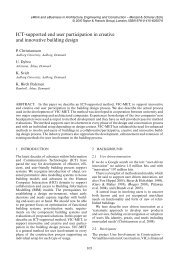
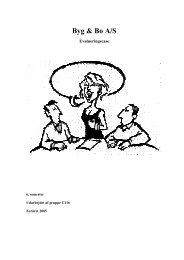
![[abs ID] PAPER TITLE - IT in Civil Engineering. Aalborg University](https://img.yumpu.com/51222254/1/184x260/abs-id-paper-title-it-in-civil-engineering-aalborg-university.jpg?quality=85)


